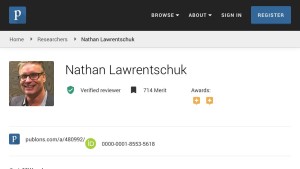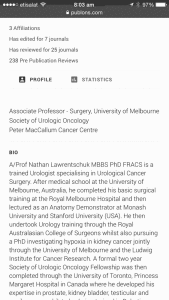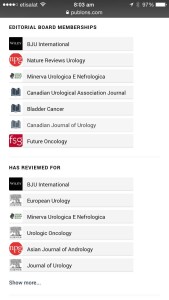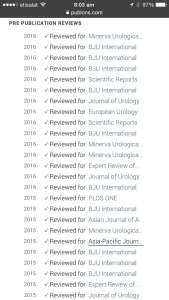Publons – Now Part Of Your Verifiable Online Digital Curriculum Vitae
Last year I introduced Publons via a BJUI Blog . It is pleasing that Wiley, the publishers of the BJUI, have now partnered with Publons to make digital archiving and verification of reviewer (and editorial) work easily accessible with a mouse click once a review is completed.
So, what is Publons again? Perhaps a brief reminder: Just as PubMed collates publications, Publons collates peer reviews you have performed and verifies you did them. With one hyperlink you may go to all of your reviews listed by date and under sections of journals. In addition, Publons also allows you to showcase to what editorial boards you belong. It also now allows editorial board work to be collated and rewarded.
I can do this all myself, can’t I? Well yes you can but this service is free and offers third party verification of peer reviews. This is important in the era of fake news. You also find out when an article you reviewed is published.
Publons is important because until now it has been difficult to track and quantify the hard work done by reviewers that is all pro bono. Getting credit for reviews is important and this website finally acknowledges that fact. Finally you can compete with other colleagues (all friendly of course). For those with editorial roles for journals the handling of manuscripts can also be collated to again get credit. A final side point is that making your reviews public is possible should you choose to do so (and gets your more points) but that is an individual (and sometimes journal) decision.
Reminder how to access and use Publons:
1) The journal may be aligned with Publons (as BJUI now is) so just click the box at time of review (see example here):
2) Simply forward your official thank-you receipt email as below to reviews@publons.com and they will do the rest (example here):
3) I can’t find the emails- is there any way of back tracking to reviews done over the years? Yes- take screen shots of your “Official Journal Dashboard “like this de-identified one below and send to reviews@publons (I have done this and it works quite well but you may need to take more than one screen shot per page to make it more easily digestible)
4) You can ask a journal to email you a summary and provided they send enough detail Publons will look at it and probably accept it (I have not done this but heard it may work)
So there you have it. The variety of methods is straightforward. A new Publons dashboard will be created and is easy and documents well which journals you have reviewed for and when.
What are the Publons awards? We can see here in the example of Prof Henry Woo (urologist, Australia) whom has reviewed many papers (see his total score and review numbers). Publons also ranks overall reviewer status and within different reviewers topic sections. It also gives “awards” each quarter to the best reviewer overall, best from your university etc. The value of such awards is likely to rise each year as more people use the Publons platform.
Are there other benefits? Well for Editors and Publishers to be able to tap into key reviewers will be extraordinary moving forward.
So its easy and free to join and benefit from Publons and the earlier you start the easier it is to track your digital online CV. Get credit and build your online presence (it allows a photo and short biography and links to your ORCID identification) and gain a sense of accomplishment by being a peer reviewer- without whom journals would not exist. It is also quite fun to see how your colleagues are ranked (or others from your country, specialty and university) and also the ridiculous number of reviews people from different fields has done.
Nathan Lawrentschuk PhD MBBS FRACS
Associate Editor BJU International/Editor USANZ BJU International Supplement
University of Melbourne AUSTRALIA











